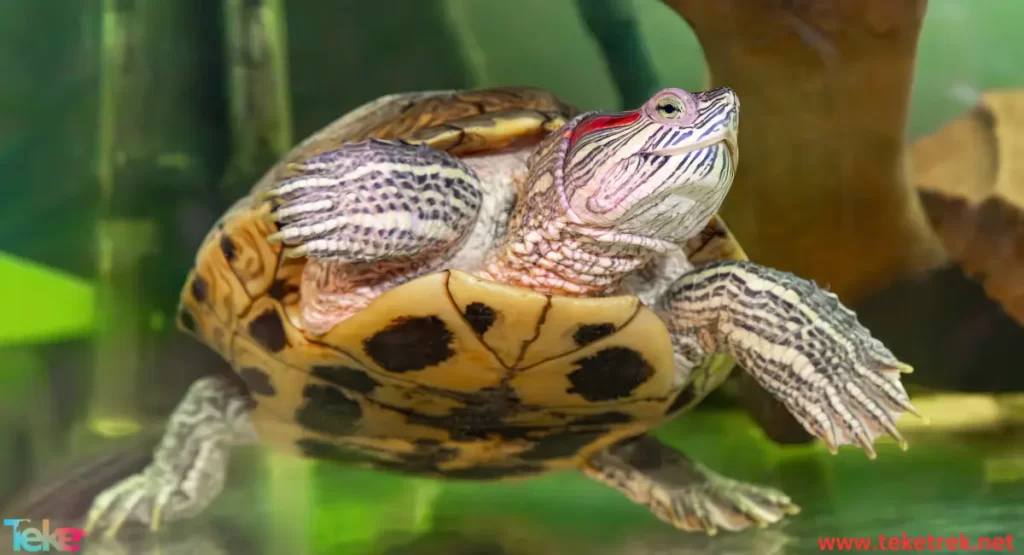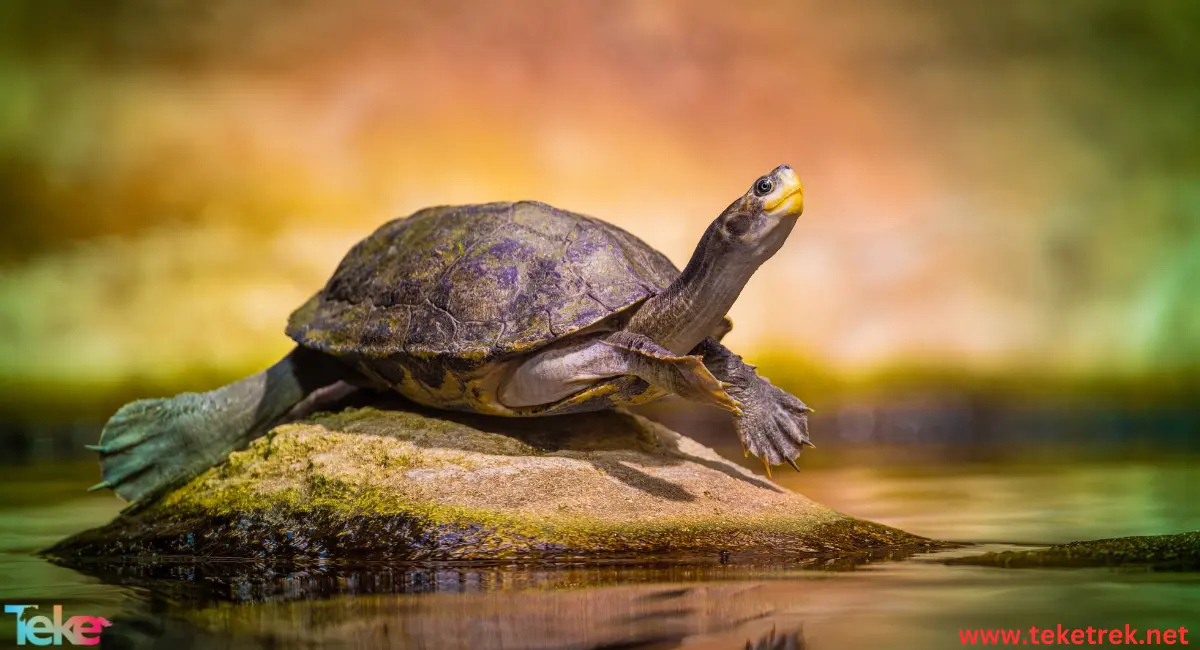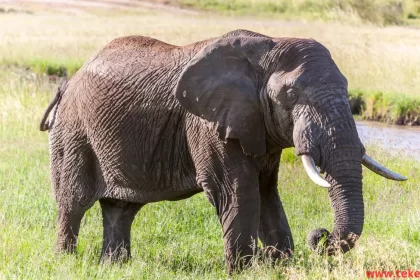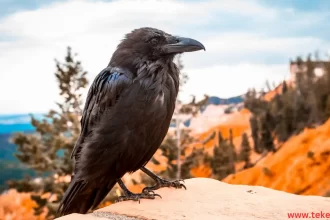The turtle are full of excitement and adventure, as they can live for over a century, yet few people know about their fascinating life cycle. Their life cycle begins as an egg, and after hatching, they face a whole world of challenges. If you want to learn more about turtles, their evolution, and their unique characteristics, keep reading this article from Teketrek.
The turtle appearance
- The turtles is reptiel animal, protect themselves with a hard shell called a “carapace,” which is made up of small pieces of bones and membranes.
- Turtles have a long neck that allows them to reach food and water, and the length of the neck varies among different turtle species.
- Turtles have strong, straight legs that end in pointed toes, aiding them in swimming and moving on land.
- Some turtles have a long tail extending from the base of the carapace, assisting them in movement in the water.
- The turtle’s body is covered with small shields that protect it from external factors and natural enemies.
- Turtles come in various colors ranging from green, brown, and gray, to black, with colors varying among different turtle species.

Locations of the turtle and its areas of distribution
Turtles are found all over the world, whether in freshwater or saltwater, on land or in wetland areas. Turtle species vary in their distribution and habitat preferences, including:
1- Some turtle species, such as sea turtles, inhabit oceans and seas, where they are found in tropical and temperate regions.
2- Tortoises and forest turtles are found in various regions worldwide, including the Americas, Africa, and Asia, inhabiting both dry and moist environments.
3- Many turtle species inhabit freshwater environments such as rivers, lakes, and ponds, distributed across most regions of the world.
4- Some specialized turtle species are found in deserts and arid regions, adapting to harsh and fluctuating environmental conditions.
Turtle life cycle
Although all turtles undergo a similar life cycle, there may be slight variations in each stage of development. Turtles, unlike other animals, have a complex life cycle. Many turtle species have distinct habitats where they can live and reproduce. However, it is non mammal animals depends on the species.
Typically, a turtle’s life cycle consists of four main stages:
1- Egg Stage:
The first stage of a turtle’s life cycle is the egg stage. During the breeding season, female turtles migrate to their nesting areas. After a few weeks of mating, turtles lay their eggs near the beach, often close to it. Turtles use their front flippers to dig a large hole once they reach above the high tide line or marshy ground.
Depending on the species, turtles can produce between 50 to 200 eggs with soft shells. After laying the eggs, the turtle covers the nest with sand and hides it by tossing branches or other debris around it, then swims back into the ocean.
Turtles bury their eggs, providing them safety, then leave and go far away, unlike other animals that stay nearby. Turtle eggs are spherical or oval and have a soft texture. The time it takes to build the nest ranges from 45 minutes to 5 hours.
2- Hatching Stage:
The hatching stage is the next stage of a turtle’s life cycle. The time it takes for the eggs to hatch depends on the temperature of the sand surrounding the nest. Baby turtles develop a temporary tooth called a “caruncle” while still in the egg.
Hatchlings use their structures to break out of their eggshells when it’s time to hatch.
Usually, hatchlings leave the nest at night to avoid predators and heat exhaustion.
Hatchlings have a residual yolk sac on the underside of their shell when they first hatch.
Turtles are fed by the yolk sac until they start searching for food.
One astonishing fact is that the nest temperature doesn’t only control the incubation period but also the sex of the turtle. Eggs hatch into female turtles in warm weather, while in colder weather, they hatch into male turtles.
3- Juvenile Stage:
The turtle hatchling develops into a juvenile and moves to coastal areas after spending a year or two in the ocean. Hatchlings may move to an extremely productive ocean area where they can find enough food until they reach adulthood.
Usually, foraging sites have plenty of food, but they also often contain many predatory animals living there. Therefore, hatchlings must wait until they become strong enough to avoid predators and escape them in coastal locations.
4- Adult Stage:
The final stage of a turtle’s life cycle is the adult stage. Depending on the species, turtles reach adulthood between 10 to 50 years old. When turtles reach sexual maturity, they are referred to as adults. However, a turtle’s outward appearance doesn’t always indicate whether it’s an adult or not.
While some turtles remain small-sized, even in their thirties, some can grow larger at a younger age. On the other hand, female turtles may reach adulthood before reaching sexual maturity.
The only way to know if a turtle is sexually mature is by tracking its hatching time and monitoring its development until adulthood.
Turtles travel to mating areas after reaching sexual maturity, where they eat and accumulate enough food. Female turtles migrate to these areas to lay their eggs, while male turtles migrate there for mating.
The distance between nesting and feeding areas can range from hundreds to thousands of miles. Most females return to the nests where they first appeared.
It is said that turtles return to mate and reproduce on the same beach or area they initially appeared in as hatchlings.
Mating habits of turtles
In the adult stage of the turtle’s life cycle, these creatures begin mating. Mature male and female turtles sexually migrate from feeding areas to breeding grounds near nesting areas once the mating season begins. Male turtles can be highly aggressive during this time and attempt to mate with as many females as possible.
Turtle Lifespan
Depending on their species, turtles have a wide range of lifespans. Medium-sized pet turtles can live anywhere from 10 to 80 years; however, larger species can easily live for over 100 years.
Interesting facts about turtles
- Turtles exhibit slow and steady movement, walking slowly on land and swimming steadily in water.
- Turtles vary in size, with some species being small, measuring only a few inches, while others are large, exceeding meters in length.
- People consider turtles long-lived creatures, as some species can live for decades or even centuries.
- Some turtle species can survive without food for long periods due to their ability to store energy in their bodies and their slow metabolic rates.
- Some scientists believe that turtles may not feel pain in the same way humans and other creatures do, indicating a different evolution of the nervous system.
- The largest turtle species is the leatherback sea turtle. An adult leatherback can measure from 1.2 to 1.9 meters in length and weigh from 200 to 506 kilograms. The largest recorded leatherback weighed 916 kilograms.
- Turtles have small sheets of skin covering their inner ear bones. While their hearing is not highly sensitive, turtles can hear to some extent because the layers of skin allow low-frequency vibrations and sound to reach the ear canals.
- The type of turtle and its natural environment have a significant impact on its diet. Some turtles are carnivorous, while others are strictly herbivorous. However, the majority of turtles are omnivores and consume both plants and animals.
- All turtles lay eggs, which they bury in plants, sand, or soil. While some species produce only a few rectangular eggs, others can produce up to 100 or more spherical eggs.


The most famous species of turtles
- Red-Eared Slider:
The Red-Eared Slider is the most popular turtle species globally and is often kept as a pet due to its hardy nature and easy care requirements. It is also popular for its beautiful appearance, with vibrant red markings on its head.
- Eastern Box Turtle:
The Eastern Box Turtle is a famous pet due to its small size and unique appearance, featuring a high-domed shell and vibrant colors. It is popular for its gentle nature and ease of care.
- Russian Tortoise:
The Russian Tortoise is a well-known pet due to its small size and easy care requirements. It is also popular for its long lifespan, with some individuals living up to 50 years.
- Green Sea Turtle:
The Green Sea Turtle is famous for its large size and unique appearance, with a streamlined shell and bright green color. It is essential for marine ecosystems.
- Leatherback Sea Turtle:
The Leatherback Sea Turtle is a popular turtle species due to its large size and unique appearance, featuring a soft, rubbery shell. It is the largest sea turtle species and plays a crucial role in maintaining ocean health.
FAQ
One of the most common questions about the turtle:
- What are the characteristics of turtles?
Turtles have the characteristics of reptiles: they breathe with two lungs, their heart consists of two atria and one ventricle, and their skin is surrounded by horny scales. In addition, the turtle’s skeleton is composed of bone tissue, and it adapts to the temperature of the external environment.
- How many times does a turtle lay eggs in a year?
Turtles lay eggs 3 times a year
- What does a turtle eat?
The wild tortoise feeds on shrimp, moths, worms, and crickets, while the domestic tortoise can be fed sardines, fish meat, chicken, cow, and turkey.
- Where do turtles live?
Turtles have adapted to live in various environments, but are found mostly in southeastern North America and southern Asia.
- How old are turtles?
The lifespan of most species ranges between 10 to 15 years, while some reach 150 years.
In summary, the turtles are remarkable creatures essential for ecosystem balance. However, as nearly all turtle species are at risk of extinction, people and organizations must protect and conserve them. If you are interested in keeping a turtle as a pet, make sure to gather as much information as possible to provide it with a suitable environment and ensure its well-being.






